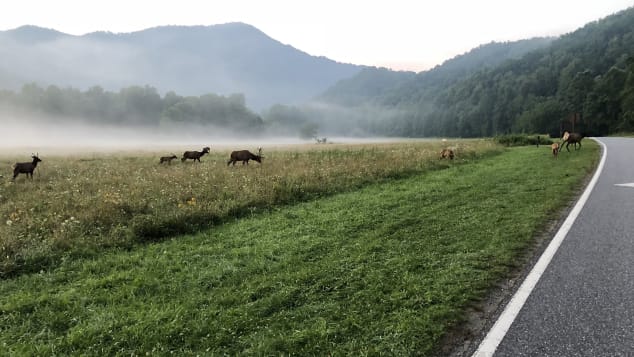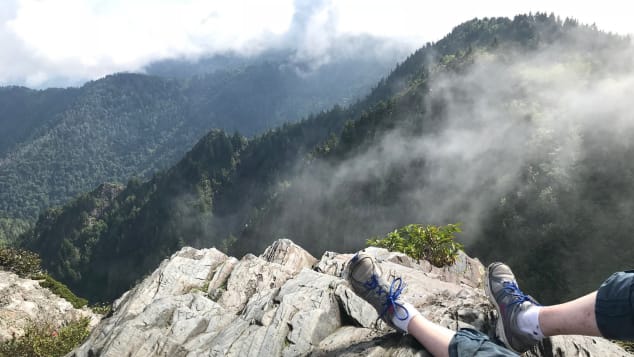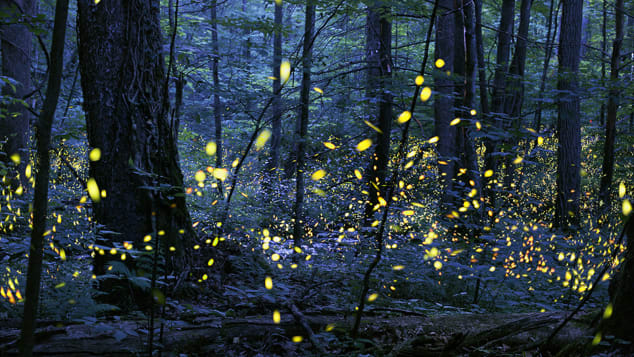Things to do in Great Smoky Mountains National Park
It’s not the largest US national park, but with more than 11 million guests in 2018, Great Smoky Mountains National Park is certainly the most visited.
Set on both sides of the North Carolina-Tennessee border, the park encompasses some 800 square miles (2,072 square kilometers) in the Southern Appalachian Mountains and is free to enter — though there is a fee for camping.
The park’s activities are as diverse as its flora and fauna. From fishing to watching synchronized fireflies, there is plenty to do in this national park.
Peak times in the Smokies are July 1 through August 15 and all of October (autumn leaf season). While summer and fall are great times to visit, you might want to plan your trip outside those busy periods if you like alone time with nature.
Here are some suggestions of things to do in Great Smoky Mountains National Park on your next visit:
Driving

You can see wildlife (in this case, elk) right from the road.
Great Smoky Mountains National Park
First things first: How will you be navigating the park?
With more than 384 miles (618 kilometers) of paved and gravel road, auto touring is a perfect way to see the Smokies.
A few popular drives include:
— Roaring Fork: Named after one of the largest, fastest-moving mountain streams in the park, this road provides excellent views of wildflowers, old growth forests, historic building as well as access to Rainbow Falls and Grotto Falls trailheads. The road is closed in winter.
— Clingmans Dome: At 6,643 feet (2,035 meters), Clingmans Dome is the highest point in Tennessee and the park. Walk a half mile up to the observation deck for exquisite panoramas or stop at one of the many scenic pullovers to take in the surrounding ridges and valleys.
— Newfound Gap: This pass is the lowest point you can drive through in the park and allows you to experience the flora and fauna of North and the South as you gain 3,000 feet in elevation.
Blue Ridge Parkway
Head out onto the Blue Ridge Parkway for a slow-placed drive with phenomenal views.
If you’re a cyclist, there’s plenty of road you can cover, too, although you might encounter vehicle congestion, steep terrain and less-than-ideal road surfaces. The 11-mile, one-way Cades Cove Loop is a great option for wildlife viewing via bicycle.
Be sure to check for seasonal and weather-related road closures as well as other travel tips.
Hiking

A hiker takes a deserving rest and soaks in the view on the Charlies Bunion Hiking Trail. Drifting patches of clouds are a frequent and enchanting part of the park experience.
Great Smoky Mountains National Park
Great Smoky Mountains National Park is a hiker’s paradise: There are 150 official trails in the park. How does one choose?
For stellar waterfall views, check out:
— Ramsey Cascades: You’ll gain 2,000 feet in elevation on the four-mile hike up to the park’s tallest waterfall. Watching water drop from 100 feet above is well worth it for experienced hikers. This eight-mile roundtrip hike takes about five to seven hours, is moderately strenuous and follows many streams and rivers.
— Indian Creek and Tom Branch Falls: Two waterfalls for the price of one, anybody? You can access this easy 1.6 mile roundtrip via the Deep Creek Trail. You’ll see the 60-foot Tom Branch Falls before you reach the Indian Creek Junction. There you’ll hang a right and soon catch your first glimpse of Indian Creek Falls.
— Mouse Creek Falls: Accessible by Big Creek Trail, 45-foot Mouse Creek Falls are off the beaten path. The moderate, four-mile roundtrip hike takes about two to three hours to complete. You’ll encounter fewer hikers on this one, and there’s a bench to rest on for a bit and view the falls.
Read up on water safety and check on trail conditions before you go.
Appalachian Trail
The Appalachian Trail is the world’s longest hiking-only trail. Its 2,180-plus miles run from Georgia to Maine, and 71 of those miles are located in the park.
Most people can do the park’s stretch of the trail in about seven days, or you can cut your time in half by using Clingmans Dome or Newfound Gap as a midpoint and arranging pickup transportation. You must reserve a permit for all multiday backpacking trips and backcountry overnight stays.
Wherever you chose to hike, be prepared and stay safe by consulting the park’s site on hiking safety before your trek.
Feeling slightly less intrepid but want still want to explore learn about the park? Ranger-guided programs are offered spring through fall. Check out the park’s calendar for details.
Fishing, wildlife viewing and history

Bears can be the most exciting in the park but keep your distance. If a bear takes notice of you, you’re too close.
Great Smoky Mountains National Park
Fishing is permitted year-round in the park and with 2,900 miles of streams, anglers have full access to one of the last protected wild trout populations in the Eastern US from just before sunrise to just after sunset.
Because the park is covered dense forest, winter is the best time for viewing wildlife, although valleys such as Cataloochee and Cades Cove can offer clear sightings of turkeys, foxes, black bear and elk.
Remember to help keep the park’s animals protected and yourself safe: Always keep a respectful distance from wildlife, and never share your food.
The park has more than 90 historic structures and some of the most well-preserved log buildings in the region. Some of the best examples can be found at Cades Cove, Cataloochee and Oconaluftee.
Speaking of history, exploring the park’s cemeteries offers great insight into the customs of the surrounding area.
Fireflies and fall leaves

One of the park’s most ethereal treats: synchronous fireflies.
Great Smoky Mountains National Park
While summer and fall are busier times in the Smokies for sure, there are a couple draws (outside of favorable weather) to braving the crowds and visiting these times of the year:
The park is home to at least 19 species of fireflies, one of which being synchronous fireflies — the only species in the United States that can synchronize flashing patterns. This phenomena tends to peak in late May to early June each year.
If you’re interested in observing this unison bioluminescence in action, make sure to keep an eye on lottery registry dates (typically late April) as a very limited amount of cars are permitted in the park to witness the event.
https://edition.cnn.com/travel/article/great-smoky-mountains-things-to-do/index.html















